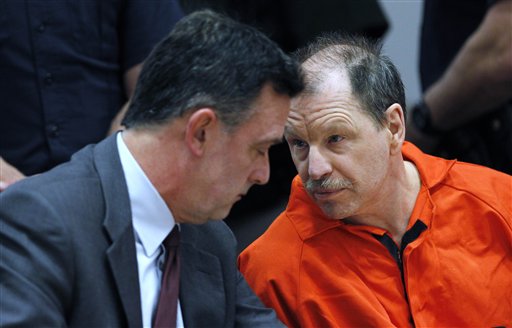We have a fascination in America about murder. Serial killers, mass murders, thrill kills, the so-called “mission murderers” who think it’s their duty to rid the world of certain groups like prostitutes, drug users or the homeless. That all those prime-time television shows, replete with mysterious murders and the resulting criminal trials are so popular speaks volumes.
Videos by Rare
But what is the reality? How many murders are there in America? Who are the victims and their killers? What parts of the country are most dangerous?
The FBI’s latest figures tell us there were 14,168 killings in the U.S. in 2012. That’s slightly higher than the rate in 2011. Unlike other crimes, such as burglary, robbery, rape and assault, which are historically under-reported by a surprisingly large margin, the murder rate is considered to be pretty accurate because it’s awfully hard to hide a corpse.
Not surprisingly, the statistics show that murder is much more prevalent in major urban areas as opposed to suburban or rural areas.
After all the headlines about Chicago being on track to become the murder capital of the U.S., the top 10 deadliest cities may surprise you.
On the top of the 2012 list: Flint, Mich., which sees 64.9 murders for every 100,000 citizens. Detroit, Mich. is next with 54.6 murders for every 100,000 in population. New Orleans has 53.5 murders among every 100,000 citizens, St. Louis’ rate drops considerably from that level — to just 35.5 homicides per 100,000 in population. Baltimore has 35 murders for every 100,000 citizens and Birmingham, Ala., comes in at 33.7. Tied at No. 7 on the list was Newark, N.J., and Oakland, Calif., each reporting 33.1 homicides per 100,000. Rounding out the top 10 list: Baton Rouge, La., (28.9); Cleveland, Ohio, (24.6) and Memphis, Tenn. (24.1).
In the book, “Myths and Realities of Crime and Justice,” by sociologists Steven Barkan and George Bryjak, the authors explain that 40 years ago, murders most often occurred between people who knew each other. In the mid-60s, detectives learned to assume that the victim was acquainted with the killer — a friend, lover or relative. Back then, police had an astounding 91-percent arrest rate. In the 1990s, arrests of suspected killers happened 65 percent of the time. Today, when so many people are murdered by total strangers, the number of arrests is just 33 percent in some urban neighborhoods.
So, who is killing whom, and who are the victims? About 65 percent of the time, males are murdering other males, but 22 percent of their targets are women. That’s not to say women don’t kill, too. Females murder men most often, but about 2.4 percent of all homicides are women killing other women.
The FBI’s 2010 report reveals that black victims are killed by other blacks 90 percent of the time. White victims are killed by other whites 83.4 percent, which clearly busts the myth that racial tensions frequently lead to murder.
A startling point in the FBI stats: While black Americans constitute less than 14 percent of the population, in more than one out of two homicides, the fatality is a black person. Interestingly, the FBI does not maintain a tally for Latinos or Asians.
As to the mode of murder — whites are more likely to die by poison, during workplace violence or in a sex-related killing. The numbers show Blacks and Latinos are over-represented in drug-related deaths.
Homicides go up in the months of July, August, December and on the weekends when people are out and about together either trying to beat the heat or holiday shopping. And, yes, handguns are the favored weapon of choice for today’s killer. The average age of the killer is about 27 years old.
There is no one general motivation for murder. But authors Barkan and Bryjak do cite extenuating circumstances frequently found in a murderer’s background: poverty, drugs, lack of education, crowded living conditions and family problems.
“Your chances of committing crime depend, to a large extent, on your gender, social class, and race/ethnicity,” they wrote. “(That) heavily influences how and/or where you are raised and socialized and (that) in turn heavily influences your chances of committing a crime.”
The most often asked question I get about the homicide rate is, “How many serial killers are out there?” Honestly, I don’t think anyone knows for sure how many are operating at any given time in the U.S. Experts who study and write about such killers put the number between 35 and 100. Personally, I’d go with the lower number, but realize there are thousands of victims of these fiends still out there — either unfound or unidentified as a victim of a serial killer.
Gary Ridgway, the so-called Green River Killer, was convicted of murdering 49 prostitutes in Seattle. He’s suspected of killing more than 90 women. Where are their bodies?
Charismatic Ted Bundy confessed to killing 36 women, but authorities estimate the total number of his kills could run upward of 100.
In the aforementioned myth-busting book, the authors quote experts who conclude, “Most of these (serial killers) are more cruel than crazy, with a disorder of character rather than of the mind.”
We can all agree that the homicide rate is too high in the U.S. Yet, there is some comfort to be found in all these statistics. Consider that only about three out of every 1,000 men (0.3%) are arrested for a violent crime each year. That means 99.7 percent are not arrested. And, serial killers are responsible for only 1 or maybe 2 percent of all U.S. murders.
So, no matter how many murders you hear about on televsion, it is unlikely that you or anyone you know will ever be a victim.
© CREATORS.COM



